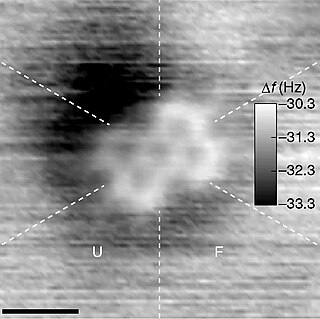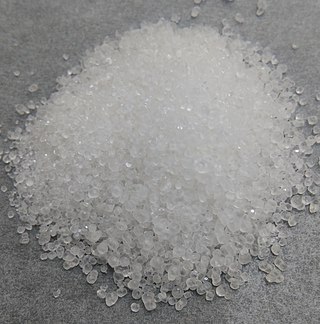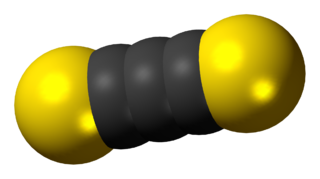The molecular formula C5H6N2 may refer to:
The molecular formula C5H6N2 may refer to:
In chemistry, a chemical formula is a way of presenting information about the chemical proportions of atoms that constitute a particular chemical compound or molecule, using chemical element symbols, numbers, and sometimes also other symbols, such as parentheses, dashes, brackets, commas and plus (+) and minus (−) signs. These are limited to a single typographic line of symbols, which may include subscripts and superscripts. A chemical formula is not a chemical name since it does not contain any words. Although a chemical formula may imply certain simple chemical structures, it is not the same as a full chemical structural formula. Chemical formulae can fully specify the structure of only the simplest of molecules and chemical substances, and are generally more limited in power than chemical names and structural formulae.

A molecule is a group of two or more atoms held together by attractive forces known as chemical bonds; depending on context, the term may or may not include ions which satisfy this criterion. In quantum physics, organic chemistry, and biochemistry, the distinction from ions is dropped and molecule is often used when referring to polyatomic ions.
Benzol may refer to:

Casomorphin is an opioid peptide derived from the digestion of the milk protein casein.

4-Aminopyridine (4-AP, fampridine, dalfampridine) is an organic compound with the chemical formula C5H4N–NH2. The molecule is one of the three isomeric amines of pyridine. It is used as a research tool in characterizing subtypes of the potassium channel. It has also been used as a drug, to manage some of the symptoms of multiple sclerosis, and is indicated for symptomatic improvement of walking in adults with several variations of the disease. It was undergoing Phase III clinical trials as of 2008, and the U.S. Food and Drug Administration (FDA) approved the compound on January 22, 2010. Fampridine is also marketed as Ampyra (pronounced "am-PEER-ah," according to the maker's website) in the United States by Acorda Therapeutics and as Fampyra in the European Union, Canada, and Australia. In Canada, the medication has been approved for use by Health Canada since February 10, 2012.
Aminopyridine may refer to any of several chemical compounds:

QMC@Home was a volunteer computing project for the BOINC client aimed at further developing and testing Quantum Monte Carlo (QMC) for use in quantum chemistry. It is hosted by the University of Münster with participation by the Cavendish Laboratory. QMC@Home allows volunteers from around the world to donate idle computer cycles to help calculate molecular geometry using Diffusion Monte Carlo.

Rilmazafone is a water-soluble prodrug developed in Japan. Once metabolized, rilmazafone is converted into several benzodiazepine metabolites that have sedative and hypnotic effects. These metabolites induce impairment of motor function and have hypnotic properties.

Carbon subsulfide is an organic, sulfur-containing chemical compound with the formula C3S2 and structure S=C=C=C=S. This deep red liquid is immiscible with water but soluble in organic solvents. It readily polymerizes at room temperature to form a hard black solid.

Potassium voltage-gated channel subfamily C member 2 is a protein that in humans is encoded by the KCNC2 gene. The protein encoded by this gene is a voltage-gated potassium channel subunit (Kv3.2).
Dioxin may refer to:
The molecular formula C19H28O3 may refer to:

Ciclotizolam (WE-973) is a drug which is a thienotriazolodiazepine derivative. It is a partial agonist for the benzodiazepine site of the GABAA receptor, with similar binding affinity to related compounds like brotizolam, but a low efficacy.
The molecular formula C12H18BrNO2 (molar mass: 288.18 g/mol, exact mass: 287.0521 u) may refer to:

2-Aminopyridine is an organic compound with the formula H2NC5H4N. It is one of three isomeric aminopyridines. It is a colourless solid that is used in the production of the drugs piroxicam, sulfapyridine, tenoxicam, and tripelennamine. It is produced by the reaction of sodium amide with pyridine, the Chichibabin reaction.
Octynes are alkynes with one triple bond and the molecular formula C8H14.
Nonynes are alkynes with one triple bond and the molecular formula C9H16.
Decynes are alkynes with one triple bond and the molecular formula C10H18.
Sodium hypobromite is the inorganic compound with the formula NaBrO. It is usually obtained as the pentahydrate, so the material that is usually called sodium hypobromite has the formula NaOBr • 5H2O. It is a yellow-orange solid that is soluble in water. It adopts a monoclinic crystal structure with a Br–O bond length of 1.820 Å. It is the Na+ salt of OBr−. It is the bromine analogue of sodium hypochlorite, the active ingredient in common bleach. In practice the salt is usually encountered as an aqueous solution.

2,2′-Dipyridylamine is an organic compound with the formula (C5H4N)2NH. It consists of a pair of 2-pyridyl groups (C5H4N) linked to a secondary amine. The compound forms a range of coordination complexes. Its conjugate base, 2,2′-dipyridylamide, forms extended metal atom chains.